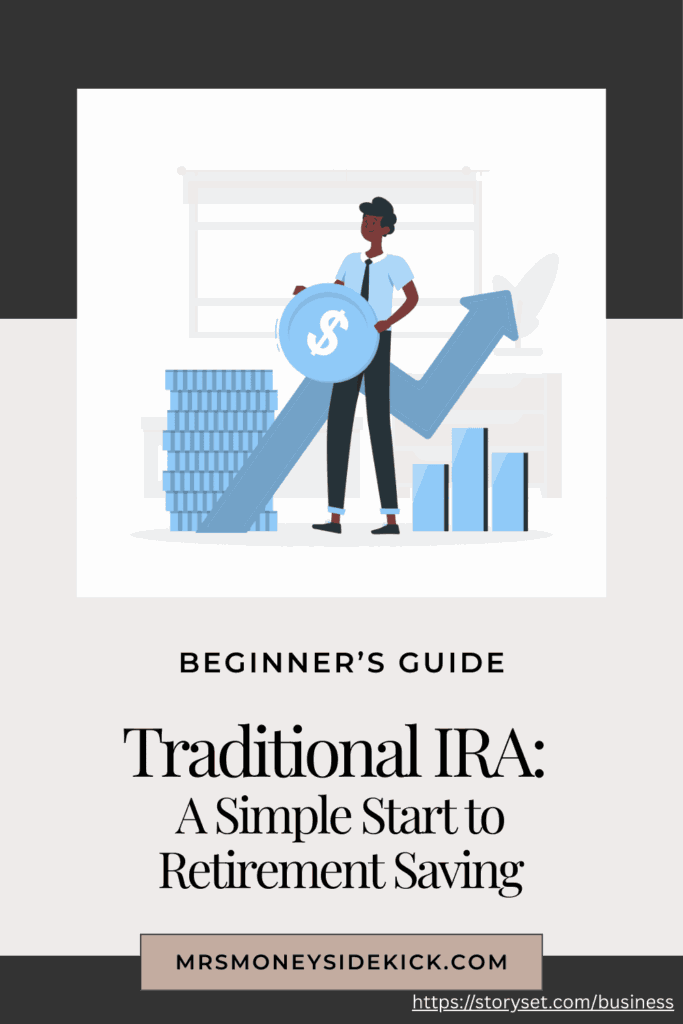Beginner’s Guide to Traditional IRA
If you’re just starting to think about retirement, welcome! This beginner’s guide to traditional IRA will walk you through everything you need to know, without the confusing jargon. Whether you’re fresh out of college or just trying to get serious about your money, understanding how a Traditional IRA works can give your future a major boost.
Let’s break it down in simple terms, with some helpful tips and a personal story to show why starting early really pays off.
What Is a Traditional IRA?
IRA stands for Individual Retirement Account. A Traditional IRA is a type of retirement savings account where you can invest your money and potentially grow it tax-deferred, meaning you don’t pay taxes on your investment gains until you withdraw the money later, usually in retirement.
This beginner’s guide to traditional IRA isn’t about throwing financial terms at you. So here’s what it really means:
- You put money in (usually from your paycheck).
- You may get a tax deduction now (lowering your current taxable income).
- Your money grows over time (interest, dividends, and investments can all compound)
- When you retire and take it out, that’s when you pay taxes on it.
It’s like planting a seed today and letting it grow in a tax-free greenhouse until you’re ready to harvest it.
My Story: The First Year I Worked…
The first year I got a job, I was just excited to have a paycheck. Saving for retirement was the last thing on my mind. But my dad had different plans. He sat me down and told me I needed to contribute to a Traditional IRA to take advantage of the tax deduction. I didn’t fully get it at the time. I remember thinking, why lock up money I won’t be able to use for decades? At the time, I was more focused on saving for a car than for retirement. But I followed his advice anyway. I didn’t question it much—I just did it.
Years later, I’m really glad I listened. Back then, I didn’t understand how powerful compound growth and tax advantages could be—but those early contributions gave me a head start. I do wish I had invested the money right away, though. I didn’t know how to choose my investments, so the money just sat there for a few years. Still, I’m thankful I contributed when I did, because there’s a yearly limit, and once that year passes, you can’t go back and add more. By the time I learned what to invest in, at least the money was already there, ready to grow.

Who Can Open a Traditional IRA?
As part of this beginner’s guide to traditional IRA, let’s go over the basics:
- You need to have earned income. This means money from a job, not gifts or investment returns.
- There’s no age limit to contribute (as long as you’re earning income).
- In 2025, you can contribute up to $7,000 if you’re under 50, and $8,000 if you’re 50 or older.
What’s the Tax Benefit?
Here’s the part most people love: you might get a tax deduction. That means the money you put into a Traditional IRA can reduce your taxable income for the year, possibly putting you into a lower tax bracket and saving you money come tax time. But not everyone qualifies for the full deduction. It depends on two things:
- If neither you nor your spouse is covered by a workplace retirement plan: Your Traditional IRA contributions are fully deductible regardless of income.
- If you are covered by a workplace retirement plan: Deduction limits apply based on your Modified Adjusted Gross Income (MAGI).
Understanding Modified Adjusted Gross Income (MAGI)
In this beginner’s guide to Traditional IRA, it’s essential to grasp the concept of Modified Adjusted Gross Income (MAGI), as it plays a pivotal role in determining your eligibility for deducting Traditional IRA contributions.
What is MAGI?
MAGI is your Adjusted Gross Income (AGI) with certain deductions added back in. While AGI includes your total income minus specific deductions (like student loan interest or tuition), MAGI recalculates this by adding back those deductions to assess eligibility for various tax benefits.
How to Calculate MAGI
To compute your MAGI:
- Start with your AGI: This is found on line 11 of IRS Form 1040.
- Add back specific deductions:
- Student loan interest
- Tuition and fees
- Foreign earned income and housing exclusions
- Tax-exempt interest
- Employer-provided adoption benefits
For a detailed breakdown, refer to the IRS guidelines on MAGI calculation.
Quick Table: 2025 Traditional IRA Deduction Limits
| Filing Status | Covered by Work Plan? | Full Deduction Income Limit | Partial Deduction Range | No Deduction Above |
| Single | Yes | $79,000 or less | $79,001 – $89,000 | Over $89,000 |
| Married Filing Jointly | Yes (you) | $126,000 or less | $126,001 – $146,000 | Over $146,000 |
| Married Filing Jointly | Yes (spouse) only | $236,000 or less | $236,001 – $246,000 | Over $246,000 |
(These numbers are updated for the 2025 tax year.)
Pros and Cons of a Traditional IRA
As part of this beginner’s guide to Traditional IRA, let’s take a look at the key pros and cons to help you decide if it’s the right fit for your retirement savings.
Pros:
- Potential tax deductions on contributions.
- Tax-deferred growth on investments.
- Wide range of investment options.
- No income limits for making contributions.
Cons:
- Required Minimum Distributions (RMDs) must begin at age 73 or 75, depending on your birth year.
- Taxes are due upon withdrawal.
- Early withdrawals may incur penalties.

How to Open a Traditional IRA
Opening an IRA is easier than you might think. You can do it online in less than 15 minutes with places like:
- Fidelity
- Vanguard
- Charles Schwab
- Betterment
💡 Pro-tip: Look for providers with no account minimums and low fees. Once it’s open, you can transfer money from your checking account and start investing.
What Can You Invest In?
A Traditional IRA isn’t just a savings account, it’s more like a toolbox. You can fill it with:
- Stocks
- Bonds
- Mutual funds
- ETFs
- CDs
💡 Pro-tip: If you’re new to investing, a target-date fund is a great hands-off option. Just pick the year you plan to retire, and it adjusts automatically as you get closer to retirement.
When Can You Take the Money Out?
This beginner’s guide to traditional IRA wouldn’t be complete without a heads-up on withdrawal rules.
- You can start withdrawing without penalties at age 59½.
- If you take money out earlier, you’ll usually pay a 10% penalty plus income taxes.
- At age 73, required minimum distributions (RMDs) begin—you must start taking out a certain amount each year.
💡 Pro-tip: Don’t withdraw early unless it’s an emergency. Let your money grow!
Should You Contribute If You Can’t Deduct?
Even if your Traditional IRA contributions aren’t tax-deductible, it’s still worth contributing. As explained in this beginner’s guide to Traditional IRA, your investments will grow tax-deferred, meaning you won’t pay taxes on the gains until you withdraw them in retirement. You can also report non-deductible contributions using IRS Form 8606 to make sure you don’t get taxed twice when you take the money out later.
Other Types of IRAs
Since this is the beginner’s guide to Traditional IRA, we’ll keep the focus here for now. There are other types of IRAs you might want to explore later, and we’ll cover those in future posts. But just so you know what’s out there, here’s a quick list:
- Roth IRA: Contributions are made with after-tax dollars, but qualified withdrawals are tax-free.
- SEP IRA: Designed for self-employed individuals and small business owners, allowing higher contribution limits.
- SIMPLE IRA: For small businesses with fewer than 100 employees, featuring employer contributions.
- Spousal IRA: Allows a working spouse to contribute to an IRA on behalf of a non-working spouse.
- Self-Directed IRA: Offers a broader range of investment options, including real estate and private placements.
Tips and Tricks for Beginners
- Start small: Even $25 a month adds up over time.
- Automate contributions: Set it and forget it.
- Track your income: Use tax software or a spreadsheet to know if you qualify for deductions.
- Learn your options: Some years, a Roth IRA might be a better choice.
- Don’t panic about investing: Stick with diversified, low-cost funds.
Final Thoughts: Beginner’s Guide to Traditional IRA
A Traditional IRA is one of the simplest and smartest ways to save for retirement, especially when you’re just getting started. I hope this beginner’s guide to traditional IRA helped you feel a little more confident and a lot less overwhelmed.
Remember, you don’t have to understand everything perfectly on day one. I sure didn’t. I just followed my dad’s advice and started putting money away. And that small step made a big difference.
If you’re reading this, maybe this is your nudge to open your own Traditional IRA and get your future started.
On your side,
Mrs. Money Sidekick
P.S. Looking for more articles like this to learn about money essentials? Check out our other posts!
Featured Image by Business illustrations by Storyset








